
|   |

|   |
 e-mail: leelakaverivenkat@gmail.com Thirty years of dance serenading Konark's Surya Deva Photos courtesy: Odisha Tourism December 13, 2019 Undeterred by years of choppy sea winds steadily weathering its stone carvings, Konark Temple stands as an architectural poem of unparalleled magnificence in salutation to the Sun God. The Konark Festival of Dance, with a massive open air stage overlooking the tiers of the Mahamandapa (the only part of the temple fully intact) in the distant backdrop, initiated by the Odissi Research Centre as a small beginning in 1969, has grown into a mammoth event held under the auspices of Odisha Tourism Department and the State Sangeet Natak Akademi, attracting tourists from all areas. With Chinese lanterns and tombas hanging from trees and buildings, and Pant Niwas lit up, the small township has a buzz, looking decked for a wedding. Walking through illuminated gardens and pathway decorated with large Rangoli patterns, one reaches the open-air auditorium with a seating capacity of 5000, which not infrequently, is filled to near capacity watching the dances. Built round the festival are events like the sand sculpture exhibition held on the beach close by, with sand artists from abroad and India creating images expressing the theme for the year, spelt out by the organisers. While foreign artists seemed fewer, the success factor lay in this year's swelling crowds the event attracted. Conscious of local arts and people becoming the largest beneficiaries of this cultural extravaganza, the wise programming policy features one Odissi group on each of the five days, with the other reserved for selected non Odissi troupes from outside the state. Nagging the viewer's mind during this year's mixed bag of presentations was the question, "Have artists begun taking the Konark festival largesse for granted?" Is its creative essence being lost in mere ornamentation? 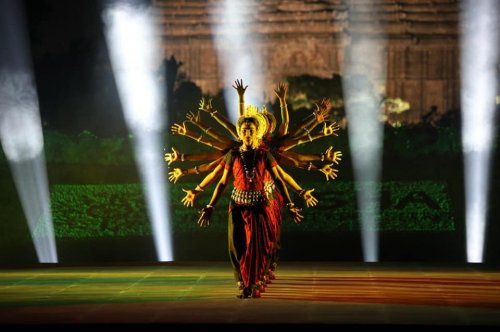 Srjan ensemble (Pic: Sabyasachi Panigrahi) Srjan's "Adityaya Namah" under the artistic direction of Ratikant Mohapatra, in a recital titled "Anweshanaa- a bouquet of neo-classical choreographs", provided a stunning curtain raiser, giving a new dimension to the inevitable prayer to the Sun God, an automatic choice for this stage, which over time has acquired a stereotypical clutch of postures of cliched calendar type images of Surya driving his chariot drawn by seven horses, eroding creative impulses. Srjan's repertory, trained to the n'th degree, with dancers in sculpted technique combining in exemplary coordination, also had Ratikant's implant of the Gotipua 'bandha nritya', with the travelling Sun and the circling round it caught through dancers in unbelievable formations creating breathtaking impact, moving to Ragamalika music by Agnimitra Behera set to jati and adi taal. The Hamsadhwani Pallavi, a Ratikant resetting for group presentation of an old Kelucharan Mohapatra choreography, became rhythmic visual geometry. Bhagavati Stuti based on Nityananda Misra's very straightforward Sanskrit script sans poetic flourish with music by Satyabrata Katha, abounded in frozen postures showing Ardhanari with Bhairav, and glimpses of Devi destroying Shumba/Nishumbha, face adorned by the glow of fire with Lord Vishnu and other Devas prostrating before such might. But both this and the finale of Bharat Janani, Bankim Chandra Chattopadhyaya's composition with Vande Mataram and music arrangement by Vijay Jena and Ramesh Chandra Das, blossoming into images of the country's flora and fauna and varied landscape, for this critic, did not go beyond the usual and what one missed was real poetic content translated into dance - specially with such a clutch of fine dancers. 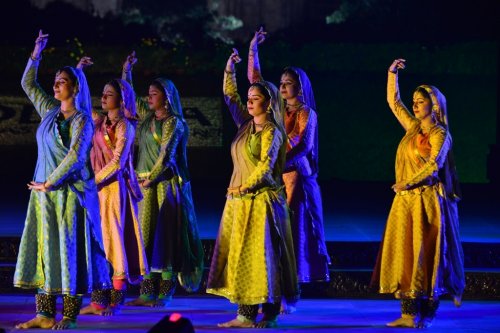 Nadroop Proven dancers, their meticulous training evident in the 7 matra roopak taal nritta, Pune's Nadroop Kathak troupe was hamstrung by sound playing hide and seek, fudging the impact of the music despite being rendered by skilful musicians. The other drawback was the absence of their Guru Shama Bhate (abroad) with her commanding parhant and conducting expertise adding so much to the performance. Without this, the nritta compositions became pure arithmetic which for a mixed audience conveyed little. Kaliyamardan and Kavit choreographed by Bhate, were followed by Chaturang where taan, sargam, sahitya and nritya bol combined creating technical virtuosity with aesthetic sensitivity. "Baje Muraliyan Baje," a melodious bhajan, caught the effect of Krishna's flute on all men and creatures of Nature. 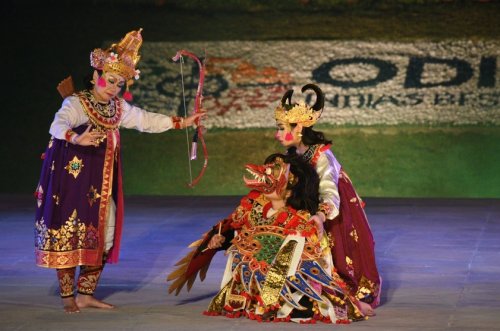 Widya Budaya This year's foreign participation featured Indonesia's Widya Budaya Balinese dance group staging Sita's abduction by Ravana, with Jatayu mortally wounded while trying to rescue her - choreographed by Gusti Bagus Adi Perbawa. Presented to Gammelan music and very colourful, one however felt that this was nowhere near the really good troupes one has seen of Balinese dance. The next choreography by Stutee Bagus Adi Perbawa was Selat Sagara, a traditional temple courtyard dance for women of all ages. 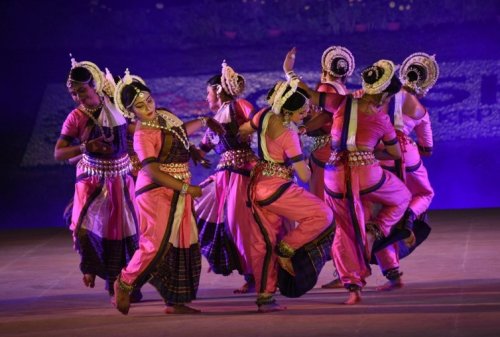 Shinjan Nrityalaya Aloka Kanungo's Shinjan Nrityalaya, after the Soorya invocation, presented Mana-Samahar Pallavi based on Ramahari's brilliant musical composition in Shankarabharanam in adi taal (Dhaneswar Swain's rhythmic inputs) revelling in variety of tihais (three times repetition of bol). Aloka's total dependence on cluster choreography with the group always moving as one unit lost the benefits accruing from energised space between dancers in different combinations - breaking off and uniting in varied formations, which the music eminently had space for. The Mahavidyas depicted through Sabdya Nrutya, on which the dancer has worked with its tantric vibrations had moments, though the entire rendition, despite the intellectual inputs, needed a kind of forceful energy the dancers could not bring to bear on the performance. 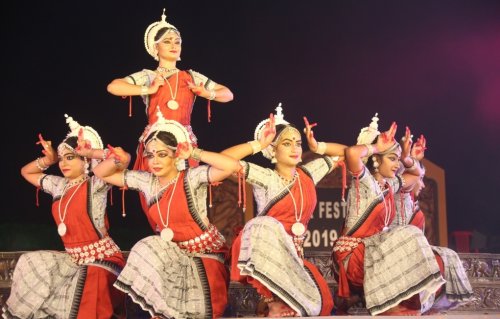 Swapnarani Sinha's group Swapnarani Sinha a senior disciple of Guru Durgacharan Ranbir, living in little known Angul was the surprise packet of this festival, having trained through her institution Nrutyanilaya, a slew of finished, powerful Odissi dancers, whose energy gave the opening Ode to Agni a fiery start. Her creative imagination revelling in unusual combinations had full play in Triveni Sangam, where the Ganga, the Yamuna and finally the Saraswati meet. Music by Ramahari Das (the sound jinx was finally conquered) was a factor - whether crossing the Ganga in a boat to a boatman's tune, or portraying Krishna and playmates (including a lame friend) frolicking on the Jamuna banks (with a fleeting Kaliyadaman impactfully rendered), or having River Saraswati on whose banks the Vedas were manifest, entering in all her dignity. Choreographic virtues apart, each dancer performed with complete authority, not as if taught, but as if Odissi was one's own body language, showing what a teacher Swapnarani is! 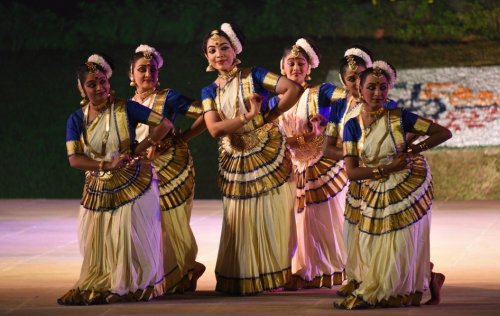 Jayaprabha Menon's group Kudos to the confidence and self- belief of Mohiniattam artist Jayaprabha Menon for daring to present with her group, a slow moving, highly repetitive, intensely inward looking Tatvam directed by Kavalam Narayana Panikar who believed that only Sopanam music really suited the body kinetics of Mohiniattam. Portraying the process of an inner journey of evolution from the concrete to the abstract, through kinetic energy which travelling through time goes beyond the temporal, this composition was built round a process of the Kundalini Sakti slowly rising. With graceful Mohiniattam torsos gyrating in a slow accelerando to Sri Narayana Guru's Kundalini paattu "Aadu Paambe" sung hauntingly by Kottayam Jayan to the snake charmer's pipe to syllables "teero tirutta tiru tiro", the rendition managing to keep a large mixed audience totally mesmerised, was an amazing feat. The other group expression based on the Jayadeva Ashtapadi "Chandana charchita neela kalebara" set to Nattai and Pantuvarali ragas, sung in the Sopanam mode of Kerala (with Satish Poduval on edakka, the percussion had a haunting quality) with the choreography as set by Jayaprabha's guru Bharati Shivaji, evoked a romantic feel of Krishna sporting with the cowherdesses on the Jamuna banks. Sapta Jeeva (auspices 7) in the seven states from the Mooladhara to the Sahasrapadma inspired from Kerala's Tayambaka tradition, built on pure rhythmic syllables in a geometric progression from slow to fast, makes for a fine ending. 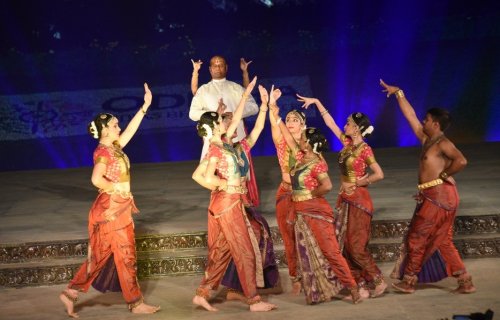 Natya Tarangini group Raja/Radha Reddy made their Kuchipudi recital by disciples from the Natya Tarangini group into an ode to India Bharata/Bharati with its vision of Satya/Ahimsa/Shanti along with the creed of non-violence as its message to the world. From Kathopanishad's Shanti paatha,"Sahana vavatu, sahanau bhunaktu sahaveeryam karavavahai" to "Swagatam Shubha Swagatam" to how Natyam the fifth Veda was created, taking one aspect from each of the Vedas, the narrative through ragas like Revati, Kalyani, Charukesi, Mohanam, Hindolam, arrived at the Navarasa Natyam wherein both Raja and Radha made a slow dignified entry with delightful cameos of various rasas, presented by both. Wonder, anger, fear, heroism evoked by Raja was contrasted by sringaram, beebhatsam, karunyam, hasyam, in Radha's portrayals with Shantam involving both. In between, the rather unsubtle didactic message of equality of religions - showing Hindu, Muslim, Sikh, Christian, Jew, Buddhist etc praying, and also a scene where daughter of the Reddys, Yamini in a solo presentation in her usual efficient fashion portrayed well held Shiva stances (it made little difference that the Urdhva tandavam one has seen her do very often fell short of total control). It was altogether a neatly packaged presentation, and fine way of registering their presence for the Reddys using this fresh line of trained students to create the framework concluding in saluting dance with the Tarangam. Kaushalya's confident nattuvangam led the presentation with fine young mridangist Manohar Balatchandirane with Ravikant and Sharanasri. 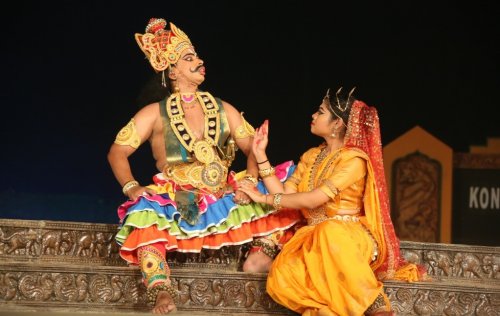 Gajendra Panda's group Gajendra Panda's dance drama based on Ganjam's old Prahlad Natak tradition, while cleverly executed, fell between two stools, with viewers unable to accept the vigorous leaping technique of the old tradition - public perceptions being now sold to prettiness of sculpted Odissi as conceived presently. With costumes and Ramahari's involved vocal support trying to be faithful to the old style, and with a very sensitively visualised starting Hiranyakashipu / Lilavati 'rati' (sringar) scene, and characters doing their bit well, the effort had its plus points. But it seemed as if even the cognoscenti had not seen much of Prahlad Natak, to judge by the responses! If the organisers do not approve of such departures, guidelines for choreographers chosen for each year's festival about not straying into over experimenting, should be made known, to restrict over enterprising composers. 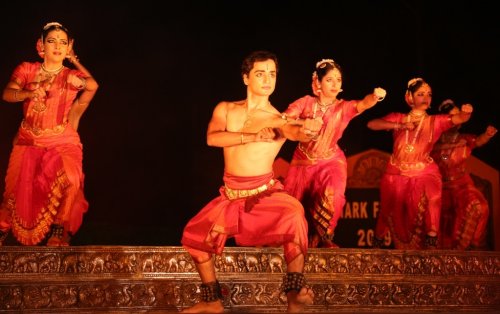 Sankhya Dance Company With his intuitive grasp, Mumbai based Bharatanatyam dancer Vaibhav Arekar's conceptualisation of dance theatre, with his scrupulously trained disciples of Sankhya Dance Company places his works in a class of their own. Saluting the temple in seated muzhumandi, backs to the audience, dawn broke in gradually with dancers to the sound of 'Om' facing the audience for the 'Hiranyaya Namah" salutation. The sheer sophistication of managing stage space with formations creating impeccable geometry of dance lines, made the now infrequently performed Tanjavur quartet Jatiswaram, garnished with peppy teermanam links in different arithmetical combinations with the Kalyani raga opening out to Todi, Suratti, Begada with solfa combinations blossoming out into movement tapestry, had to be seen to be believed! It was not mindless movements for each dancer gave everything she had to each moment of the dance. And treatment for the oft rendered Jayadeva Dashavatar, endowed it with a rare freshness as ragas like Kambodhi, Natakuranji, Shanmukhapriya, Hindolam, Mohanam and Sindhu Bhairavi followed - vocalist Kartik Hebbar meltingly mellifluous most of the time, but inexplicably hitting sudden off sruti snatches. 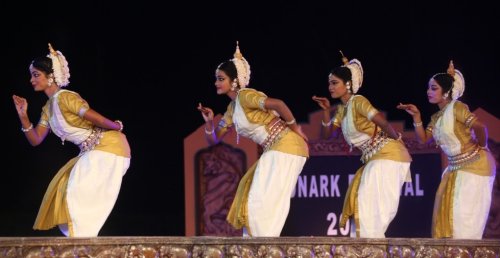 Odissi Research Centre The finale of Hamsadoota by Odissi Research Centre, an involved Harivamsha Maha Purana story regarding Indra's sly strategy (kuntaniti) using golden swans acting as love messengers uniting Krishna's sons Pradyumna, Gaja, Shamba with beautiful daughters of demon King Bajranabha - Parvati, Chandravati, Gunavati - had too much of the dialogue narrative as choreographed by Kasturi Pattnaik with Swapneswar Chakraborty's music. Monochromatic, with no redeeming points the straight forward story narrative dragged. Not the best such an institution is capable of! Odissi groups need to realise that the many opportunities coming their way in Odisha, call for putting on the thinking cap, not allowing routine to dull the performance scene.  Writing on the dance scene for the last forty years, Leela Venkataraman's incisive comments on performances of all dance forms, participation in dance discussions both in India and abroad, and as a regular contributor to Hindu Friday Review, journals like Sruti and Nartanam, makes her voice respected for its balanced critiquing. She is the author of several books like Indian Classical dance: Tradition in Transition, Classical Dance in India and Indian Classical dance: The Renaissance and Beyond. Post your comments Please provide your name and email id when you use the Anonymous profile in the blog to post a comment. All appropriate comments posted with name and email id in the blog will also be featured in the site. |